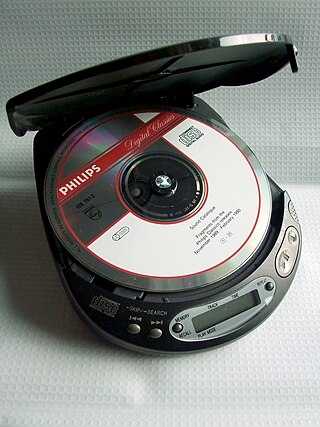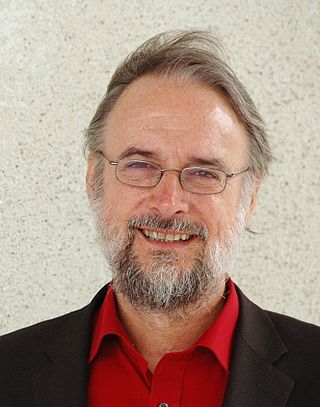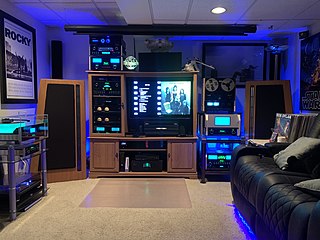
An audio tape recorder, also known as a tape deck, tape player or tape machine or simply a tape recorder, is a sound recording and reproduction device that records and plays back sounds usually using magnetic tape for storage. In its present-day form, it records a fluctuating signal by moving the tape across a tape head that polarizes the magnetic domains in the tape in proportion to the audio signal. Tape-recording devices include the reel-to-reel tape deck and the cassette deck, which uses a cassette for storage.
An audiophile is a person who is enthusiastic about high-fidelity sound reproduction. An audiophile seeks to reproduce recorded music to achieve high sound quality, typically in a quiet listening space and in a room with good acoustics.

A home cinema, also called a home theater or theater room, is a home entertainment audio-visual system that seeks to reproduce a movie theater experience and mood using consumer electronics-grade video and audio equipment and is set up in a room or backyard of a private home. Some studies show that films are rated better and generate more intense emotions when watched in a movie theater, but convenience is a major appeal for home cinemas. In the 1980s, home cinemas typically consisted of a movie pre-recorded on a LaserDisc or VHS tape; a LaserDisc Player or VCR; and a heavy, bulky large-screen cathode ray tube TV set, although sometimes CRT projectors were used instead. In the 2000s, technological innovations in sound systems, video player equipment, TV screens and video projectors have changed the equipment used in home cinema set-ups and enabled home users to experience a higher-resolution screen image, improved sound quality and components that offer users more options. The development of Internet-based subscription services means that 2020s-era home theatre users do not have to commute to a video rental store as was common in the 1980s and 1990s.

A CD player is an electronic device that plays audio compact discs, which are a digital optical disc data storage format. CD players were first sold to consumers in 1982. CDs typically contain recordings of audio material such as music or audiobooks. CD players may be part of home stereo systems, car audio systems, personal computers, or portable CD players such as CD boomboxes. Most CD players produce an output signal via a headphone jack or RCA jacks. To use a CD player in a home stereo system, the user connects an RCA cable from the RCA jacks to a hi-fi and loudspeakers for listening to music. To listen to music using a CD player with a headphone output jack, the user plugs headphones or earphones into the headphone jack.

Karlheinz Brandenburg is a German electrical engineer and mathematician. Together with Ernst Eberlein, Heinz Gerhäuser, Bernhard Grill, Jürgen Herre and Harald Popp, he developed the widespread MP3 method for audio data compression. He is also known for his elementary work in the field of audio coding, the perception measurement, the wave field synthesis and psychoacoustics. Brandenburg has received numerous national and international research awards, prizes and honors for his work. Since 2000 he has been a professor of electronic media technology at the Technical University Ilmenau. Brandenburg was significantly involved in the founding of the Fraunhofer Institute for Digital Media Technology (IDMT) and currently serves as its director.

Ray Milton Dolby Hon OBE, HonFREng was an American engineer and inventor of the noise reduction system known as Dolby NR. He helped develop the video tape recorder while at Ampex and was the founder of Dolby Laboratories.

Kornelis Antonie "Kees" Schouhamer Immink is a Dutch engineer, inventor, and entrepreneur, who pioneered and advanced the era of digital audio, video, and data recording, including popular digital media such as compact disc (CD), DVD and Blu-ray disc. He has been a prolific and influential engineer, who holds more than 1100 U.S. and international patents. A large portion of the commonly used audio and video playback and recording devices use technologies based on his work. His contributions to coding systems assisted the digital video and audio revolution, by enabling reliable data storage at information densities previously unattainable.

Sound recording and reproduction is the electrical, mechanical, electronic, or digital inscription and re-creation of sound waves, such as spoken voice, singing, instrumental music, or sound effects. The two main classes of sound recording technology are analog recording and digital recording.

Audio-Technica Corporation is a Japanese company that designs and manufactures professional microphones, headphones, turntables, phonographic magnetic cartridges, and other audio equipment.
The history of sound recording - which has progressed in waves, driven by the invention and commercial introduction of new technologies — can be roughly divided into four main periods:

KVOQ is a public radio station licensed to Greenwood Village, Colorado, and serving the Denver metropolitan area. KVOQ broadcasts an Album Adult Alternative (AAA) radio format known as "Indie 102.3" under the ownership of Colorado Public Radio. It is listener supported and airs no commercials. On-air fundraisers are conducted several times each year.
KLZ is a commercial radio station licensed to Denver, Colorado and owned by Crawford Broadcasting. KLZ received its first broadcasting license on March 10, 1922. It is the oldest broadcasting station in the state of Colorado, and one of the oldest in the United States.

WPAQ is a commercial radio station licensed to Mount Airy, North Carolina, serving the Piedmont area of North Carolina, Southwest Virginia and Southside Virginia. WPAQ is owned and operated by WPAQ Radio, Inc. It airs a mix of Americana, Bluegrass, Classic Country and Southern Gospel music, along with some brokered Christian talk and teaching shows. The transmitter and studios are on Springs Road at Mount View Drive in Mount Airy.

Home audio refer to audio consumer electronics designed for home entertainment, such as integrated systems like shelf stereos, as well as individual components like loudspeakers and surround sound receivers.
The Rainbow Music Hall was a 1,485-capacity music venue located in Denver, Colorado. The venue opened in 1979 by concert promoter Barry Fey and closed in 1989. Many famous artists performed at the Rainbow Music Hall, including:
High-resolution audio is a term for audio files with greater than 44.1 kHz sample rate or higher than 16-bit audio bit depth. It commonly refers to 96 or 192 kHz sample rates. However, 44.1 kHz/24-bit, 48 kHz/24-bit and 88.2 kHz/24-bit recordings also exist that are labeled HD Audio.

Electric music technology refers to musical instruments and recording devices that use electrical circuits, which are often combined with mechanical technologies. Examples of electric musical instruments include the electro-mechanical electric piano, the electric guitar, the electro-mechanical Hammond organ and the electric bass. All of these electric instruments do not produce a sound that is audible by the performer or audience in a performance setting unless they are connected to instrument amplifiers and loudspeaker cabinets, which made them sound loud enough for performers and the audience to hear. Amplifiers and loudspeakers are separate from the instrument in the case of the electric guitar, electric bass and some electric organs and most electric pianos. Some electric organs and electric pianos include the amplifier and speaker cabinet within the main housing for the instrument.
Joan Packard Birkland was an American athlete and women's sports advocate. Considered one of Colorado's greatest all-around athletes, she earned multiple titles in women's amateur tennis and golf championships at the city and state level. Following her retirement from competition, she served on numerous sports boards and became involved in sports education for disabled youth. She was inducted into the Colorado Golf Hall of Fame in 1977, the Colorado Sports Hall of Fame in 1981, and the Colorado Women's Hall of Fame in 1996.

The Family Dog Denver was a concert dance hall located at 1601 West Evans Avenue in Denver, Colorado. Opened from September 1967 to July 1968, it is regarded as a seminal music venue that launched Denver on its trajectory to its current status as a major concert destination by introducing never-before-seen acts like The Doors, Van Morrison, Jimi Hendrix, Cream, Buffalo Springfield, Janis Joplin, Chuck Berry, and many others. Many acts, like The Doors and Van Morrison, for example, had yet to become famous when they played The Dog, evidenced by the poster artists having to stylize the names of their leading songs into the poster art for the shows. The Family Dog is also seen as a cultural turning point in Denver from the conservative, western-minded sensibility of the early and mid-20th century to the current, liberal-minded climate. The venue's history, surrounding drama and ultimate impact had been largely unknown and unrealized until it was unearthed and detailed for the first time in the 2021 documentary The Tale of the Dog, produced and directed by Dan Obarski & Scott Montgomery and distributed by Cinedigm. As there are no useful photos, no video and little written history remaining of the Family Dog Denver, the film's oral history format told in first person by the people who were there serves as a definitive reference for “The Dog.”

Walton Stinson is an American sound engineer, business executive, and entrepreneur. He is co-founder and CEO of ListenUp, a privately held Colorado-based company that in 2019 was the 10th largest consumer electronics specialty dealer in the US. Stinson was inducted into the Consumer Electronics Hall of Fame in 2009, along with Apple co-founder Steve Jobs, Irwin M. Jacobs, former Chairman of Qualcomm, and Richard E. Wiley, former chairman of the Federal Communications Commission (FCC).













